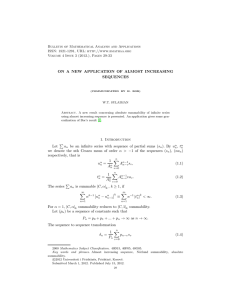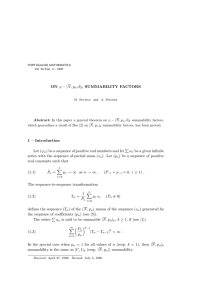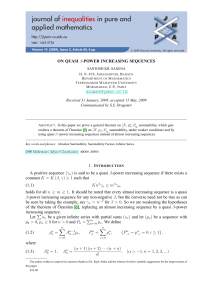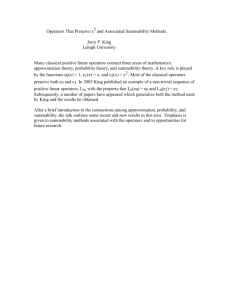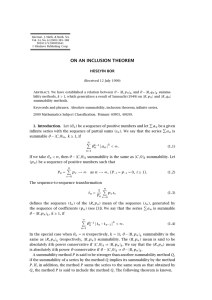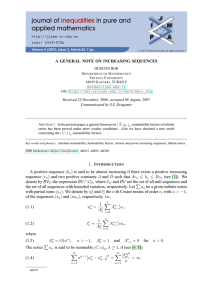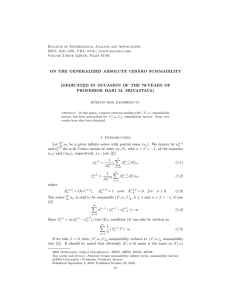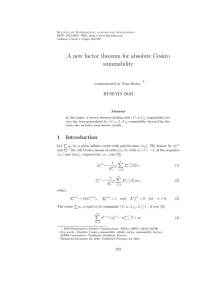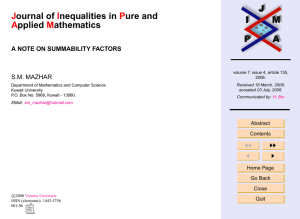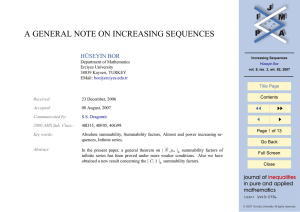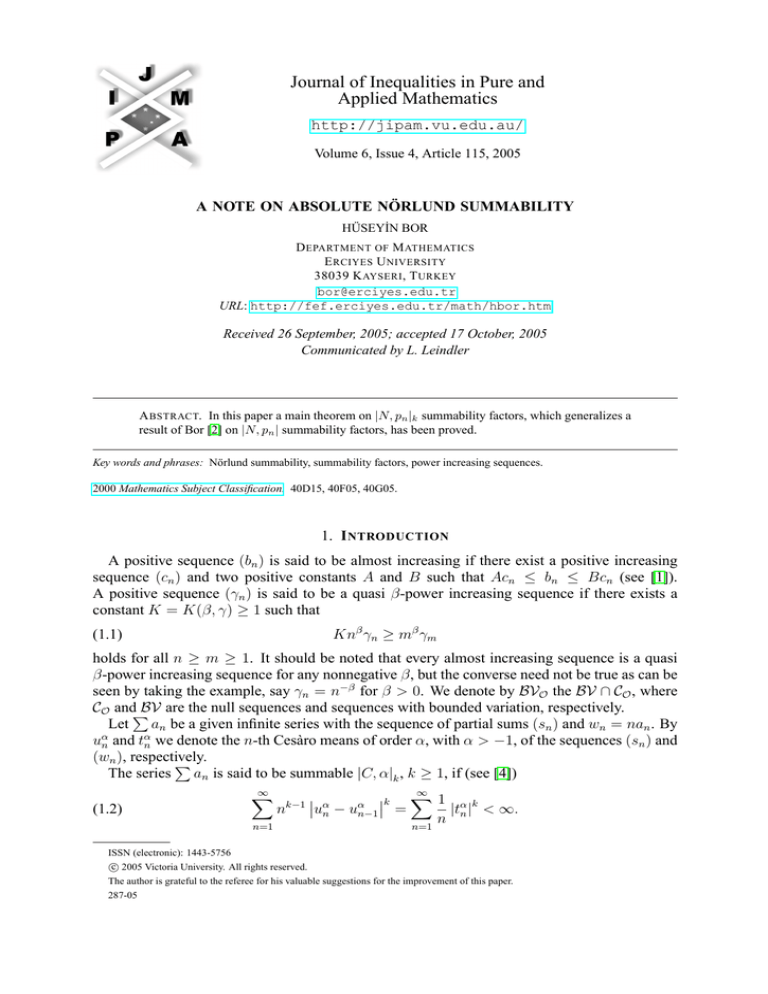
Journal of Inequalities in Pure and
Applied Mathematics
http://jipam.vu.edu.au/
Volume 6, Issue 4, Article 115, 2005
A NOTE ON ABSOLUTE NÖRLUND SUMMABILITY
HÜSEYİN BOR
D EPARTMENT OF M ATHEMATICS
E RCIYES U NIVERSITY
38039 K AYSERI , T URKEY
bor@erciyes.edu.tr
URL: http://fef.erciyes.edu.tr/math/hbor.htm
Received 26 September, 2005; accepted 17 October, 2005
Communicated by L. Leindler
A BSTRACT. In this paper a main theorem on |N, pn |k summability factors, which generalizes a
result of Bor [2] on |N, pn | summability factors, has been proved.
Key words and phrases: Nörlund summability, summability factors, power increasing sequences.
2000 Mathematics Subject Classification. 40D15, 40F05, 40G05.
1. I NTRODUCTION
A positive sequence (bn ) is said to be almost increasing if there exist a positive increasing
sequence (cn ) and two positive constants A and B such that Acn ≤ bn ≤ Bcn (see [1]).
A positive sequence (γn ) is said to be a quasi β-power increasing sequence if there exists a
constant K = K(β, γ) ≥ 1 such that
Knβ γn ≥ mβ γm
(1.1)
holds for all n ≥ m ≥ 1. It should be noted that every almost increasing sequence is a quasi
β-power increasing sequence for any nonnegative β, but the converse need not be true as can be
seen by taking the example, say γn = n−β for β > 0. We denote by BVO the BV ∩ CO , where
CO andP
BV are the null sequences and sequences with bounded variation, respectively.
Let an be a given infinite series with the sequence of partial sums (sn ) and wn = nan . By
uαn and tαn we denote the n-th Cesàro means of order α, with α > −1, of the sequences (sn ) and
(wn ), respectively.
P
The series an is said to be summable |C, α|k , k ≥ 1, if (see [4])
(1.2)
∞
X
n=1
n
k−1
∞
X
α
1 αk
un − uαn−1 k =
|t | < ∞.
n n
n=1
ISSN (electronic): 1443-5756
c 2005 Victoria University. All rights reserved.
The author is grateful to the referee for his valuable suggestions for the improvement of this paper.
287-05
2
H ÜSEYIN B OR
Let (pn ) be a sequence of constants, real or complex, and let us write
Pn = p0 + p1 + p2 + · · · + pn 6= 0, (n ≥ 0).
(1.3)
The sequence-to-sequence transformation
σn =
(1.4)
n
1 X
pn−v sv
Pn v=0
defines the sequence (σn ) of theP
Nörlund mean of the sequence (sn ), generated by the sequence
of coefficients (pn ). The series an is said to be summable |N, pn |k , k ≥ 1, if (see [3])
∞
X
(1.5)
nk−1 |σn − σn−1 |k < ∞.
n=1
In the special case when
pn =
(1.6)
Γ(n + α)
, α≥0
Γ(α)Γ(n + 1)
the Nörlund mean reduces to the (C, α) mean and |N, pn |k summability becomes |C, α|k summability. For pn = 1 and Pn = n, we get the (C, 1) mean and then |N, pn |k summability becomes
|C, 1|k summability. For any sequence (λn ), we write ∆λn = λn − λn+1 .
The known results. Concerning the |C, 1|k and |N, pn |k summabilities Varma [6] has proved
the following theorem.
P
Theorem A. Let p0 > P
0, pn ≥ 0 and (pn ) be a non-increasing sequence. If an is summable
|C, 1|k , then the series an Pn (n + 1)−1 is summable |N, pn |k , k ≥ 1.
Quite recently Bor [2] has proved the following theorem.
Theorem B. Let (pn ) be as in Theorem A, and let (Xn ) be a quasi β-power increasing sequence
with some 0 < β < 1. If
n
X
1
(1.7)
v=1
v
|tv | = O(Xn ) as n → ∞,
and the sequences (λn ) and (βn ) satisfy the following conditions
(1.8)
Xn λn = O(1),
(1.9)
|∆λn | ≤ βn ,
(1.10)
βn → 0,
X
(1.11)
then the series
P
nXn |∆βn | < ∞,
an Pn λn (n + 1)−1 is summable |N, pn |.
J. Inequal. Pure and Appl. Math., 6(4) Art. 115, 2005
http://jipam.vu.edu.au/
A N OTE ON A BSOLUTE N ÖRLUND S UMMABILITY
3
2. M AIN R ESULT
The aim of this paper is to generalize Theorem B for |N, pn |k summability. Now we shall
prove the following theorem.
Theorem 2.1. Let (pn ) be as in Theorem A, and let (Xn ) be a quasi β-power increasing sequence with some 0 < β < 1. If
n
X
1
(2.1)
v=1
|tv |k = O(Xn ) as n → ∞,
v
and the sequences (λn ) and (βn ) satisfy the conditions from (1.8) to (1.11) of Theorem B; further
suppose that
(λn ) ∈ BVO ,
(2.2)
then the series
P
an Pn λn (n + 1)−1 is summable |N, pn |k , k ≥ 1.
Remark 2.2. It should be noted that if we take k = 1, then we get Theorem B. In this case
condition (2.2) is not needed.
We need the following lemma for the proof of our theorem.
Lemma 2.3 ([5]). Except for the condition (2.2), under the conditions on (Xn ), (λn ) and (βn )
as taken in the statement of the theorem, the following conditions hold when (1.11) is satisfied:
nβn Xn = O(1) as n → ∞,
(2.3)
∞
X
(2.4)
βn Xn < ∞.
n=1
3. P ROOF OF T HEOREM 2.1
In order to prove the theorem, we
P need consider only the special case in which (N, pn ) is
(C, 1), that is, we shall prove that
an λn is summable |C, 1|k . Our theorem will then follow
by means of Theorem A. Let Tn be the n−th (C, 1) mean of the sequence (nan λn ), that is,
n
1 X
vav λv .
Tn =
n + 1 v=1
(3.1)
Using Abel’s transformation, we have
n
n−1
1 X
1 X
Tn =
vav λv =
∆λv (v + 1)tv + λn tn
n + 1 v=1
n + 1 v=1
= Tn,1 + Tn,2 , say.
To complete the proof of the theorem, it is sufficient to show that
(3.2)
∞
X
1
|Tn,r |k < ∞
n
n=1
J. Inequal. Pure and Appl. Math., 6(4) Art. 115, 2005
for r = 1, 2, by (1.2).
http://jipam.vu.edu.au/
4
H ÜSEYIN B OR
Now, we have that
m+1
X
n=2
m+1
X
1
1
k
|Tn,1 | ≤
n
n(n + 1)k
n=2
( n−1
Xv+1
v=1
v
)k
v |∆λv | |tv |
)k
( n−1
X
1
m+1
X
v |∆λv | |tv |
nk+1 v=1
( n−1
) ( n−1
)k−1
m+1
X 1 X
1X
k
= O(1)
v |∆λv | |tv | ×
v |∆λv |
n2 v=1
n v=1
n=2
= O(1)
n=2
m+1
X
n−1
1 X
= O(1)
v |∆λv | |tv |k
2
n v=1
n=2
( n−1
)
m+1
X 1 X
vβv |tv |k
= O(1)
2
n
n=2
v=1
m
X
(by (2.2))
(by (1.9))
m
X
|tv |k
1
=
O(1)
vβ
= O(1)
vβv |tv |
v
n2
v
v=1
v=1
n=v+1
= O(1)
m−1
X
k
∆(vβv )
v=1
= O(1)
m−1
X
m+1
X
v
X
|tr |k
r=1
r
+ O(1)mβm
m
X
|tv |k
v=1
|∆(vβv )| Xv + O(1)mβm Xm
v
(by (2.1))
v=1
= O(1)
m−1
X
|(v + 1)∆βv − βv | Xv + O(1)mβm Xm
v=1
= O(1)
m−1
X
v |∆βv | Xv + O(1)
v=1
= O(1)
m−1
X
|βv | Xv + O(1)mβm Xm
v=1
as m → ∞,
in view of (1.11), (2.3) and (2.4).
Again
m
m
k
X
X
1
k
k |tn |
|Tn,2 | =
|λn |
n
n
n=1
n=1
=
m
X
|λn |k−1 |λn |
n=1
= O(1)
m−1
X
n=1
= O(1)
m−1
X
∆ |λn |
m
X
|tn |k
|tn |k
= O(1)
|λn |
n
n
n=1
n
X
|tv |k
v=1
v
+ O(1) |λm |
|∆λn | Xn + O(1) |λm | Xm
(by (2.2))
m
X
|tn |k
n=1
n
(by (2.1))
n=1
= O(1)
m−1
X
βn Xn + O(1) |λm | Xm = O(1)
as m → ∞,
n=1
J. Inequal. Pure and Appl. Math., 6(4) Art. 115, 2005
http://jipam.vu.edu.au/
A N OTE ON A BSOLUTE N ÖRLUND S UMMABILITY
5
by virtue of (1.8) and (2.4). This completes the proof of the theorem.
R EFERENCES
[1] S. ALJANČIĆ
(1977), 5–22.
AND
D. ARANDELOVIĆ, O-regularly varying functions, Publ. Inst. Math., 22
[2] H. BOR, Absolute Nörlund summability factors, J. Inequal. Pure Appl. Math., 6(3) (2005), Art. 62.
[ONLINE http://jipam.vu.edu.au/article.php?sid=535].
[3] D. BORWEIN AND F.P. CASS, Strong Nörlund summability, Math. Zeith., 103 (1968), 94–111.
[4] T.M. FLETT, On an extension of absolute summability and some theorems of Littlewood and Paley,
Proc. London Math. Soc., 7 (1957), 113–141.
[5] L. LEINDLER, A new application of quasi power increasing sequences, Publ. Math. Debrecen, 58
(2001), 791–796.
[6] R.S. VARMA, On the absolute Nörlund summability factors, Riv. Math. Univ. Parma (4), 3 (1977),
27–33.
J. Inequal. Pure and Appl. Math., 6(4) Art. 115, 2005
http://jipam.vu.edu.au/

